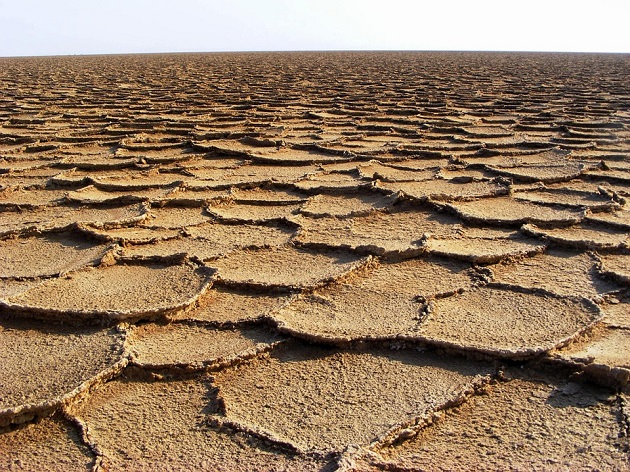2017年度、京都大学入学試験、英語、長文読解の問題に挑戦してみましょう。
地球の砂漠化、乾燥地帯の問題についての論説文です。早速、挑戦です。
次の英文を読んで設問に答えなさい。
設問
下線部(A)の指す内容を具体的に日本語で表して和訳しなさい。
下線部(B)を、“As such”の指す内容が具体的分かるように和訳しなさい。
下線部(C)を和訳しなさい。
問題文をよく読みながら、設問に解答してみたいと思います。
問題文
The most common conception of deserts and arid lands, as embodied by the 1994 UN Convention to Combat Desertification, innumerable national development agencies, and many nongovernmental organizations, is that they are barren, deforested, overgrazed lands - wastelands with little value that need to be repaired and improved.
1994年の国連反砂漠化協定、無数にある国営開発企業、そして多くの非政府組織が示しているように、砂漠や乾燥地帯に最も共通する概念はそれらは不毛で森林が伐採され過放牧された、修復や改善を必要とするほとんど価値のない荒れ地だということだ。
– conception:概念、考え。
– arid:乾燥した。
– embody:体現した、取り入れた。
– innumerable:数え切れない、無数の。
– barren:不毛な、貧弱な、無力な。
Up to 70% of global arid and semiarid lands are frequently claimed to be suffering from varying degrees of desertification.
地球上の乾燥地帯あるいは準乾燥地帯の70%までは砂漠化の何らかの段階にさらされていると非常に頻繁に報告されている。
– arid:乾燥した。
– claim:主張する、要求する、言い張る。
– suffer from:病む、わずらう、苦しむ、傷つく、損害をこうむる。
– desertification:砂漠化。
Yet the word "desertification" has no agreed definition, measures of desertification are not standardized, and it is very difficult to differentiate degradation caused by humans from the effects of drought in the drylands, which makes(A) such estimates of desertification questionable at best.
しかし「砂漠化」ということばには未だに合意された定義はないし、砂漠化の測定方法も標準化されていなのであって、さらに人為的に荒廃が進んだのか乾燥地の干ばつによるものなのかを区別するのも非常に難しいことであり、それがそのような砂漠化の推定、つまり、「地球上の乾燥地帯あるいは準乾燥地帯の70%までは砂漠化の何らかの段階にさらされているという推定」、を非常に疑問の残るものにしている。
– agreed:合意された
– differentiate from:区別する。
– degradation:下がること、劣化すること。
– drought:干ばつ。
設問(1)下線部(A)の指す内容を具体的にして、ということですから、そのようなestimate、「数値的な評価」を伴う見積もり、と考えますと、前の文の「70%までが~」とされてる部分を指していると考えられます。
そこで、解答は「地球上の乾燥地帯あるいは準乾燥地帯の70%までは砂漠化の何らかの段階にさらされているという推定」となります。
また、このセンテンスの最後の部分は関係代名詞の継続用法となっており、whichの先行詞はこの場合はカンマの前にあります、it is very difficult to differentiate degradation caused by humans from the effects of drought in the drylandsの全体を指していると考えられます。
Indeed, academic research has shown for more than 25 years that estimates of desertification have been significantly exaggerated and that most of the world's drylands are not being invaded by spreading deserts caused by deforestation, burning, and overgrazing as claimed since the word was first invented nearly one hundred years ago.
そのことばがおよそ100年前に初めて考え出されて以来、学術的調査は25年以上にわたって、砂漠化の推定は必要以上に誇張され、世界の乾燥地のほとんどは主張されるように森林伐採、焼畑、過放牧による砂漠の拡大に侵食されたのではなかったと示してきた。
– exaggerate:誇張する、過大視する、強調しすぎる。
– invent:発明する、でっち上げる。
This has led a majority of arid lands ecologists to conclude that there is insufficient scientific evidence of large-scale permanent desertification.
そしてそれが乾燥地生態学者の大多数に大規模な永続的な砂漠化の充分な科学的証拠といえるものはないと結論付けさせた。
– insufficient:不十分な
Desertification as a concept is extremely important, however, not least because the fear it generates drives a multimillion-dollar global anti-desertification campaign that impacts the lives of millions of people.
しかし、砂漠化に対する恐れが何百万人の生活にも影響を与える数百万ドル規模の世界的な反砂漠化キャンペーンを少なからず始めさせたのだから、概念としての砂漠化というものは非常に重要なのである。
– not least:少なからず
– fear:恐れ
– generate:作り出す
– drive:引き起こす
– the fear it generates drives~:fear とitの間に目的格関係代名詞が省略されています。
Desertification is also important because it was the first major environment issue to be recognized as occurring on a global scale.
また砂漠化ということは地球規模で発生しているものとして認識された最初の重大な環境問題であったことからも重要なのである。
(B) As such, the way that the "crisis of desertification" was conceptualized, framed, and tackled as a policy problem shaped in numerous ways our reactions to subsequent environmental crises such as deforestation, biodiversity loss, and climate change.
そういうことから、つまり砂漠化が地球規模で発生しているものとして認識された最初の重大な環境問題であるということから「砂漠化の危機」が政治問題として、概念化され、枠組みが作られ、取り組むべきものとされたそのやり方がさまざまな方法で後に続く森林伐採や生物多様性の喪失や気候変動といった環境問題に対する我々の対応の仕方を形作った。
– as such:直前のセンテンスを指摘しています。
– numerous:多くの
– reaction:反応
– crises:crisisの複数形
– このセンテンス:主語はthe way、動詞はshaped、目的語はreactionsです。
Global concern about desertification is most commonly dated to the 1970s when a great drought and famine hit the sub-Saharan region with terrible suffering and mortality, and resulted in coordinated global action in the form of the 1977 UN Conference on Desertification.
砂漠化についての地球規模での懸念が共有されたのは大規模な干ばつや飢饉がサハラ砂漠以南を襲い甚大な被害や死者を出した1970年代に翻り、1977年の国連砂漠化会議という形で世界的な行動を始めることとなったのだった。
– dated to 1970s:1970年代と日付られている
– suffering:災害
– mortality:多数の死者
Fear of desertification, though, has driven global dryland policy for much longer, dating to mid-twentieth century with UNESCO's Arid Zone Program and to various colonial adventures in the world's drylands long before that.
しかし砂漠化の恐れがかなり長くにわたって世界的な乾燥地帯政策を推進したのであり、それはユネスコの乾燥地政策が始まった20世紀中程あるいはそれよりはるか前の世界の乾燥地でのさまざまな植民地的進出にまで遡る。
Indeed, before the word "desertification" was invented in the 1920s by French colonial forester, western imperial powers had executed many different programs to try to restrain the perceived spread of desert regions and also to try to "restore" the drylands to productivity according to capitalist goals.
実際に、フランスの植民地森林監督官により1920年代に「砂漠化」ということばが考案される以前において、西洋の帝国主義列強は資本主義の目的に応じた生産性のために、認識されている砂漠の拡大を抑制しようとした多くの様々な計画を実施したのであり、また乾燥地を修復しようともしたのだった。
Underlying these attempts was a complex, long-standing, and primarily Anglo-European understanding of deserts which equated them with ruined forests much of the time.
こういった試みの根底にあったものはほとんどの場合砂漠を荒廃した森林と見なす複雑で長く続いた主にアングロヨーロッパ的な考え方だった。
Examining how these ideas about deserts have changed over the long duration will reveal that many of the worst cases of degradation in the drylands have been the result of policies based on the old ideas that deserts are without value and that desertification is caused primarily by "traditional" uses of the land by local populations.
砂漠についてのこれらの考え方がどのように長きにわたって変化してきたかを検証することは乾燥地の劣化の最悪のケースの多くが砂漠は無価値であるという、また砂漠化はその地の人々の伝統的な土地使用に主に起因するものだという古い考え方に基づく政策の結果だったことを明らかにするだろう。
Societies in arid lands have, in fact, lived successfully in these unpredictable environments for thousands of years using ingenious techniques.
事実として、独創的な技術により何千年にもわたり予想もできない環境で、乾燥地において、社会の人々は上手く生きてきた。
(C) The assumption that the world's drylands are worthless and deforested landscapes has led, since the colonial period, to programs and policies that have often systematically damaged dryland environments and marginalized large numbers of indigenous peoples, many of whom had been using the land sustainably.
植民地時代以来、世界の乾燥地は無価値で森林伐採された土地の様相であるという前提が、しばしば乾燥地の環境を組織的に破壊し非常に多数の先住民を周辺地域に追いやった事業や政策を導いてきた。その先住民はその土地を持続的に活用していたのにもかかわらず。
– marginalize:軽んじる、特定の人々を境界の外へ追いやる
– indigenous people:先住民
– このセンテンス:主語はassumption、動詞はhas led、目的語はprograms and policiesです。最後の節は関係代名詞の継続用法でありmany of whomの先行詞はindigenous peopleです。
おわりに
長文中の特定部分の和訳でした。
全文を読まなくても解答できれば時間が節約できますが、全体の主旨を理解しないと正しく和訳するのは難しいかもしれません。
設問(1)では、少なくとも問題文の初めから、下線(A)の含まれるセンテンスの最後までを理解しないと正しく答えられないと思います。
設問(2)では下線部(B)とその直前のセンテンスを正確に理解する必要があります。
設問(3)も、文章全体の流れからくる帰結ですので、このセンテンスだけを理解し和訳するのは難しいかもしれません。
長文読解もトレーニングを重ねることで、読むスピードや理解を早めることができると思います。また、長文においては一つ一つのセンテンスも、接続詞や関係詞によってかなり長くなっていることが多いのですが、これも経験を積んでいけば、早く正確に読み取ることができるようになります。時間をかけて、勉強を続けていきましょう。
![EnglistA [イングリスタ]](https://www.english360.jp/mgp2/wp-content/uploads/2015/09/site-title.gif)


